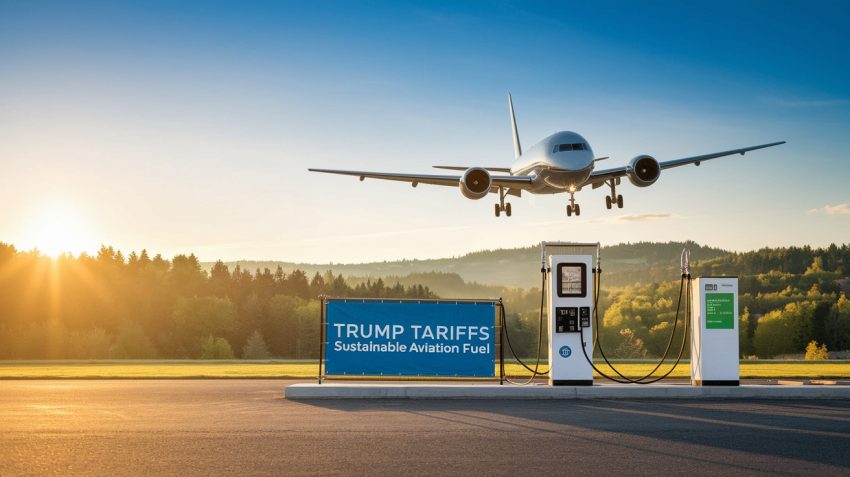Sustainable Aviation Fuel (SAF) is widely recognized as a cornerstone in reducing the aviation industry’s carbon footprint. With global carbon neutrality goals intensifying, SAF has drawn increasing support from regulators, airlines, and investors. The path to scaling SAF has faced major roadblocks, none more significant than the economic ripple effects of the Trump-era trade war.
The trade conflict, characterized by aggressive tariff regimes aimed at key international partners such as China and the EU, affected nearly every major industry, and SAF was no exception. From feedstock pricing volatility to industrial equipment shortages, the impact on SAF development was substantial. This article explores how the Trump administration’s trade war shaped the SAF market, caused policy shifts, altered global competitiveness, and spurred new innovations amid the chaos.
How Trump’s Tariffs Altered the SAF Supply Chain
Sustainable Aviation Fuel relies on a complex international supply chain involving feedstocks like soybean oil, used cooking oil, animal fats, and agricultural waste. Many of these are processed using imported equipment and technologies, particularly from Europe and Asia. The tariffs imposed on aluminum, steel, and high-tech machinery led to higher costs for infrastructure development. Simultaneously, tariffs on agricultural imports and exports destabilized feedstock sourcing.
The result was that SAF producers faced higher capital costs, unpredictable feedstock pricing, and regulatory uncertainty. Infrastructure build-outs slowed, research investments contracted, and airlines hesitated to commit to SAF procurement due to unstable supply and inflated prices.
SAF Cost Volatility and Investment Withdrawal
The early-stage nature of SAF commercialization meant the industry was particularly vulnerable to price shocks. With production already more expensive than conventional jet fuel, additional costs from tariffs made SAF an even tougher sell. Airlines that had pledged to reduce their carbon emissions by integrating SAF into their fuel mix were forced to delay or renegotiate contracts.
Venture capital and private equity investments in biofuel startups also saw a decline during the peak years of the trade war. The uncertainty over equipment tariffs and export restrictions created risk factors that discouraged funding. As a result, many SAF projects either scaled back or stalled entirely.
Agricultural Sector Instability and Feedstock Scarcity
A major, often overlooked aspect of the trade war was its impact on U.S. agriculture. China’s retaliatory tariffs on U.S. soybeans, corn, and other crops disrupted export flows, leading to domestic surpluses and price crashes. While this initially appeared beneficial for SAF producers relying on these feedstocks, the long-term result was lower crop yields, a shift in farmer priorities, and reduced agricultural resilience.
This feedstock uncertainty undermined planning for long-term SAF contracts, complicating the economic modeling needed for large-scale facility investments. Tariffs on imported feedstocks from countries like Argentina and Brazil further limited options for producers.
Policy Paralysis and Regulatory Delay
The Trump administration focused heavily on deregulation and promoting fossil fuels, often at the expense of renewable energy programs. SAF, still an emerging technology at the time, received limited direct support. Without robust federal incentives or a clear regulatory framework, SAF producers were left navigating a high-cost environment without a clear pathway to scale.
This policy vacuum delayed progress on SAF mandates, blending requirements, and infrastructure funding. By contrast, the European Union advanced its SAF roadmap through mandates like ReFuelEU, widening the transatlantic gap in sustainable aviation readiness.
Book Your “Trump Tariff Threat Assessment” https://www.marketsandmarkets.com/forms/ctaTariffImpact.asp?id=70301163
International Competition and Global Market Shifts
While U.S. companies struggled under the weight of protectionist trade policies, international competitors accelerated SAF production. Finland, the Netherlands, Singapore, and the UK leveraged government support and favorable trade policies to attract investment and build SAF refining capacity.
As a result, Europe and Asia-Pacific began exporting SAF to global carriers, securing long-term contracts with international airlines. U.S.-based producers, constrained by tariffs and lacking scale, missed out on these early opportunities. This shift not only reduced U.S. market share but also signaled a broader decline in American leadership in green aviation technology.
The Turnaround: Post-Tariff Recovery and Strategic Resilience
Since the end of Trump’s presidency, the Biden administration has sought to reverse many of the economic barriers faced by the SAF industry. The Inflation Reduction Act of 2022 included significant tax credits and incentives for low-carbon fuel production. These measures helped rejuvenate investor interest and sparked new SAF initiatives across the U.S.
In response to past supply chain disruptions, SAF companies are now prioritizing domestic resilience. Many have started to localize supply chains, develop non-agricultural feedstock alternatives like municipal solid waste and algae, and integrate vertically to minimize reliance on foreign equipment.
Lessons Learned: Balancing Trade, Security, and Climate
The Trump-era trade policies served as a wake-up call for the SAF sector. While the intention was to boost domestic industries, the ripple effects proved that trade isolation can hinder innovation, disrupt green goals, and weaken global competitiveness.
Policymakers today must strike a balance between protecting national interests and fostering international collaboration. SAF, by its nature, is a globally interconnected industry. Harmonizing regulatory standards, facilitating cross-border tech transfer, and maintaining open supply chains will be essential for its success.
A Stronger, Smarter SAF Industry Ahead
Despite the setbacks of the Trump-era tariffs, the SAF market has demonstrated remarkable resilience. What once seemed like insurmountable challenges have sparked innovation, localization, and strategic partnerships. The U.S. may have lost ground temporarily, but the lessons learned have laid the foundation for a more self-sufficient, stable, and forward-thinking SAF industry.
With continued policy support, investment, and international alignment, SAF will remain a critical pillar of sustainable aviation. The turbulence of the trade war has passed, but its legacy will inform the next generation of clean fuel strategies and supply chain design.
The Sustainable Aviation Fuel market is now ready for takeoff—wiser, tougher, and more determined than ever.

